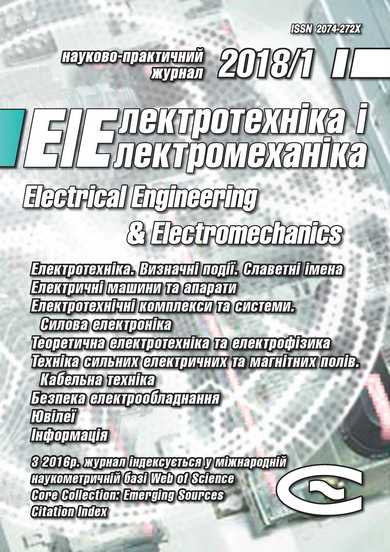LIMITATIONS OF CURRENT OF THE THREE-PHASE ACTIVE POWER FILTER IN THE CONDITIONS OF OVERLOAD AND SHORT CIRCUIT
DOI:
https://doi.org/10.20998/2074-272X.2018.1.04Keywords:
active power filter, pq-theory of instantaneous power, relay current control, effective current value, hysteresis zoneAbstract
Purpose. The purpose of the work is to develop a method of limiting the maximum allowable level of current of a three-phase active power filter in conditions of overload or short circuit and a system for the implementation of the method. Methodology. For research purposes, the provisions of the pq-theory of instantaneous power, the method of the theory of automatic control in systems with relay controllers, and the methods of simulation in the visual programming environment were used. Results. Both the overloading mode and the short circuit emergency mode, using the proposed solution, do not lead to significant changes in the voltage level on the accumulation capacitor, thus maintaining the stability of the power part of the active power filter. Originality. In the case of temporary overloads of current and short circuits at the network node to which a active power filter is connected, the current's limiting is performed by scaling the current to the level allowed by normal operation of the semiconductor elements of the device, which allows the basic operating algorithm to be implemented in the specified modes. Practical value. The proposed solution can be used as a mean to protect the power part of the device in case of overload, which, in the event of emergencies, and their elimination will automatically restore the normal mode of the device.References
1. Zhezhelenko I.V., Saenko Yu.L. Pokazateli kachestva elektroenergii i ikh kontrol' na promyshlennykh predpriiatiiakh: Ucheb. posobie dlia vuzov. 3-e izd [Indicators of quality of the electric power and their control at the industrial enterprises. Educational manual for students of higher educational institutions, 3rd ed.]. Moscow, Energoatomizdat Publ., 2000. 252 p. (Rus).
2. Davydov A.Y., Bіalobrzeski A.V. Analysis of facilities of indemnification of reactive-power is in electrical engineerings systems. Transactions of Kremenchuk Mykhailo Ostrohradskyi National University, 2010, no.3(62), part 1, pp. 132-136. (Ukr).
3. Alekseev B.A. Active harmonic filters. ELEKTRO. Electrical engineering, power industry, electrical industry, 2007, no.3, pp. 28-32. (Rus).
4. Zhemerov G.G., Ilina O.V. Fryze power theory and modern power theories. Electrical engineering & electromechanics, 2007, no.6, pp. 63-65. doi: 10.20998/2074-272X.2007.6.14.
5. Akagi H., Watanabe E.H., Aredes M. Instantaneous Power Theory and Applications to Power Conditioning. Wiley-IEEE Press, April 2007. 379 p. ISBN 978-0-470-10761-4.
6. Vlasenko R.V., Bialobrzeski O.V. Using active power filter to compensate the current component of asymmetrical non-linear load in the four wire network. Reporter of the Priazovskyi State Technical University. Section: Technical sciences, 2015, no.31, pp. 156-165. (Ukr).
7. Zakis J., Rankis I. Comparison of flexible systems of reactive power compensation. 5th International symposium «Topical problems in the field of electrical and power engineering». Doctoral school of energy and geotechnology. Kuressaare, Estonia. 14-19 January, 2008, pp. 99-102.
8. Byalobrzheskii O.V., Vlasenko R.V. Interrelation of electric-power parameters of the single-phase active power filter mode with parameters of the stores attached. Naukovyi Visnyk Natsionalnoho Hirnychoho Universytetu, 2015, no.4, pp. 79-84. (Ukr).
9. Vlasenko R.V., Bialobrzeski O.V. Comparison of inactive power compensation methods by three-phase active power filter with adaptive relay current controller. Electrical Engineering and Power Engineering, 2014, no.2, pp. 20-27. (Ukr).
10. Segeda M.S. Elekrychni merezhi ta systemy [Electric grids and systems]. Lviv, Lviv Polytechnic National University Publ., 2007. 488 p. (Ukr).
11. Dixon J.W., Tepper S., Morаn L. Analysis and evaluation of different modulation techniques for active power filters. Proceedings of 1994 IEEE Applied Power Electronics Conference and Exposition – ASPEC’94. pp. 894–900. doi: 10.1109/APEC.1994.316303.
Downloads
Published
How to Cite
Issue
Section
License
Copyright (c) 2018 R. V. Vlasenko, O. V. Bialobrzeski

This work is licensed under a Creative Commons Attribution-NonCommercial 4.0 International License.
Authors who publish with this journal agree to the following terms:
1. Authors retain copyright and grant the journal right of first publication with the work simultaneously licensed under a Creative Commons Attribution License that allows others to share the work with an acknowledgement of the work's authorship and initial publication in this journal.
2. Authors are able to enter into separate, additional contractual arrangements for the non-exclusive distribution of the journal's published version of the work (e.g., post it to an institutional repository or publish it in a book), with an acknowledgement of its initial publication in this journal.
3. Authors are permitted and encouraged to post their work online (e.g., in institutional repositories or on their website) prior to and during the submission process, as it can lead to productive exchanges, as well as earlier and greater citation of published work.





